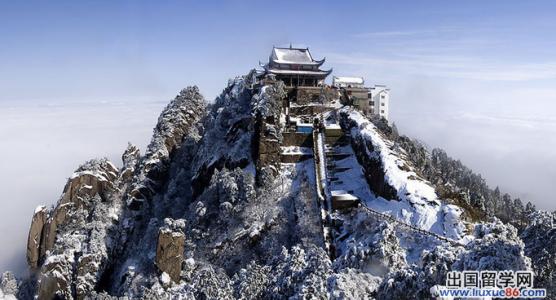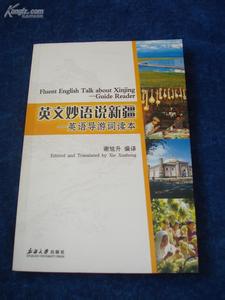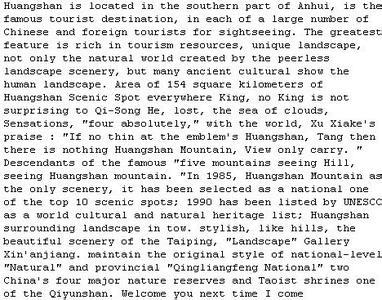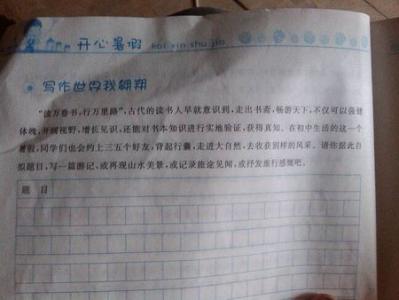九华山是中国佛教四大名山之一,首批国家重点风景名胜区。它为皖南斜列的三大山系(黄山、九华山、天目山——白际山系)之一。位于安徽省池州市东南境,西北隔长江与天柱山相望,东南越太平湖与黄山同辉,是安徽”两山一湖”(黄山、九华山、太平湖)黄金旅游区的北部主入口、主景区。下面是带来的九华山英文的导游词,欢迎欣赏。
九华山英文导游词一:Good morning! Ladies and gentlemen! Today, with such great joy, on behalf of Anhui Travel Agency. I’d like to extend our warm welcome to all of you, our distinguished guest from the other side of the Pacific. Please allow me to introduce myself. My name is Li Xin and I work for Anhui Travel Agency .During your short stay in jiuhuashan, I’ll be your local guide. It’s my honor to be of your service. If you have any request, go ahead! I’ll try my best to help you and make your stay comfortable!
It’s my honor to be of your service. If you have any special interest, please let me know, and I highly appreciate your understanding and cooperation.
Ok, now we are heading for Mt.Jiuhua, which is known as one of the four Buddhist Mountains in China. It’s about 30 minutes’ bus ride. On the way you can enjoy the beautiful scenery and I’d like to give you a brief introduction about Mt.Jiuhua.
Mt.Jiuhua was originally known as Jiuzi (Nine-Peak) Mount. Li Bai, a famous Chinese poet over 1300 years ago wrote of the mountain: ”sailing on the Yangtze River, watching Mt.Jiuhua from after, green water falls from the sky, nine lotuses appear in the air.” This expresses the poet’s great admiration for Mt.Jiuhua. From then on, the mountain was renamed as Mt.Jiuhua.
Mt.Jiuhua covers more than 100 square kilometers in area, which has been known to have 99 peaks, and the main peak of the Shiwang Peak is 1342m above sea level. Mt.Jiuhua is full of waterfalls, streams, exotic-looking boulders, ancient caves, old pines and exuberant bamboo. With the richly variegated landscape, the ancient temples are tucked away amid the dense woods and the air reverberates with the tolling of the bells at dawn and dusk. Mt.Jiuhua is usually known as the No.1 Mountain of the southeast.
Ok, I have said too much about the Mt.Jiuhua, and I expect you have got a general idea about it. Seeing is Beliving. I’m sure you will learn a lot about Chinese culture and Buddhism after the visit, and you will also be impressed deeply by the wonderful scenery. Let’s get off the bus and bring your camera. I’ll show you around the scenic areas.
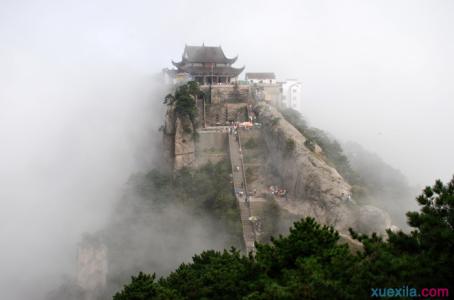
Look! So many monks, why? Yes, that’s it! Because Mt.Jiuhua is a Buddhist mountain. Especially on July 30th of Chinese Lunar is the birthday of Earch Buddha, and a great Buddhist ceremony is held on this day. Around that day every year, the mountain is the site of a temple fair. A large number of monks, nuns, pilgrims and visitors come to burn incense, chant and sacrifice food. The activities of each year are different. Though today is not the festival, we can also enjoy the beautiful scenery. They are: Sunrise at Tiantai Platform, Evening bell of Huacheng Temple, Sitting on East Stone with pleasure, Fairy mark of Tianzhu, Taoyan waterfall, clouds around lotus peak and Phoenix Pine.
Ok, here we are, this is Huacheng Temple of Jiuhua Street. It was the first and oldest of all the temples of Mt.Jiuhua. Over 1500 years ago, Monk Beidu built a simple temple here. Then after 300 years it was reconstructed and named Huacheng Temple.
You see it lies a round plaza. Look at the center! What do you see? Yeah! It is a crescent shaped lotus pond named “Crescent Moon Pond” you can go towards it, what do you see? It is believed that Monk Jin Qiaojue used to free captive fish. Ok, now I say some brief introduction about it and then you can go around it. We’ll gather here after one hour, ok? The temple consists of four parts: the lobby, the grand hall, the back hall and the Scripture Tower. The ground slopes up with each part and the whole layout is natural. The doors, windows, brackets, beams, columns, steps and the cornerstone are carved with exquisite designs. In the hall are preserved horizontal boards inscribed by emperor in ancient time.
Ok! Is everyone here? 1, 2, 3… Ok, now, let’s go to see the Phoenix Pine, in Minyuan Scenic Area. Phoenix Pine is over 1400 years old, and is one of the four decorative trees in Anhui Province.
After seeing Phoenix Pine, we’ll finish our travel, and on behalf of my company, my Chinese colleagues and myself, I’d like to take this opportunity to express my thanks for your consideration, understanding, tolerance and cooperation.
九华山英文导游词二:Mount Jiuhua is one of the four sacred mountains of Chinese Buddhism. It is located in Qingyang County in Anhui province and is famous for its rich landscape and ancient temples.
Many of the mountain’s shrines and temples are dedicated to Ksitigarbha (known in Chinese as Dìzàng, Traditional Chinese: 地藏), who is a bodhisattva and protector of souls in hell according to Mahayana Buddhist tradition. Pious Buddhists often come to this popular attraction in Anhui to climb to Greater Tiantai peak, which is regarded as Jiuhuashan’s most important peak, although it is not the tallest.
History of Jiuhua Mountain
Jiuhu Mountain, known as a Buddhist wonderland and famous for its large number of temples and beautiful scenery, has been a resplendent pearl of Chinese cultural heritage.
Jiuhua Mountain was formed in the late Cenozoic Era, and Buddhism began in the Northern and Southern Dynasties (420-589) at the mountain. According to historical records, a monk named Fuhu built Fuhu Convent in 503; Monk Tanhao practised Buddhism here in 713; During 713-755, Jin Qiaojue, a Korean aristocrat, came to Jiuhua Mountain and lived in a stone cave at Dongya Peak. His hard practice moved the local people, and they contributed money to build a temple for him. In 781 the local official Zhang Yan presented a memorial to the emperor for the horizontal inscribed board "Huacheng". Upon Jin Qiaojue’s nirvana, it was said that the mountain roared, birds and monkeys cried, and the earth gave out fire and light. His body kept lively three years later, so he was respected as the Earth Buddha, wrapped with earth and has been preserved to present. Roushen Pagoda was built to revere him, and thus Jiuhua Mountain has become the place where Earth Buddhist rites are performed.
The history of Buddhism at Jiuhua Mountain can be divided into five periods: founded in the middle of Tang Dynasty ; decayed from the late Tang Dynasty to the Five Dynasties; slowly developed in the Song and Yuan Dynasties; and greatly developed in the Ming and Qing Dynasties. In the Ming Dynasty, the emperors granted money to rebuild Huacheng Temple for three times and two emperors bestowed inscriptions. The number of temples and nunneries was over a hundred, and many monks and nuns came. It was listed as one of the four famous Buddhist mountains, besides Wutai Mountain, Emei Mountain, and Putuo Mountain.
 爱华网
爱华网